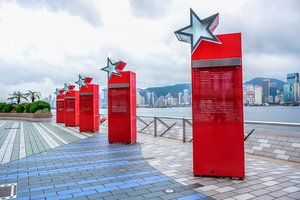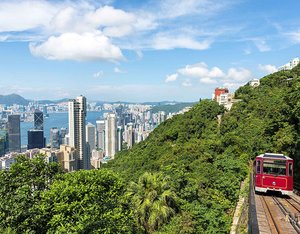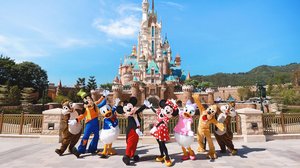Attractions to Visit
-
Avenue of Stars
 At
its peak, only Hollywood and Bollywood produced more movies in a year than Hong
Kong, and homegrown names like Bruce Lee, Jackie Chan, Jet Li, Shaw Brothers,
John Woo and Wong Kar-wai are famous worldwide. Avenue of Stars pays tribute to
Hong Kong’s enviable cinematic history and the stars that have made such an
impact. Grab selfies with Hong Kong legends such as martial arts master Bruce
Lee, singer and actress Anita Mui, as well as beloved cartoon character McDull
along the waterfront; compare hand sizes on over 100 handprint plaques set into
the wooden handrail, and soak in the breathtaking view of the Victoria Harbour
right in front of your very eyes.
At
its peak, only Hollywood and Bollywood produced more movies in a year than Hong
Kong, and homegrown names like Bruce Lee, Jackie Chan, Jet Li, Shaw Brothers,
John Woo and Wong Kar-wai are famous worldwide. Avenue of Stars pays tribute to
Hong Kong’s enviable cinematic history and the stars that have made such an
impact. Grab selfies with Hong Kong legends such as martial arts master Bruce
Lee, singer and actress Anita Mui, as well as beloved cartoon character McDull
along the waterfront; compare hand sizes on over 100 handprint plaques set into
the wooden handrail, and soak in the breathtaking view of the Victoria Harbour
right in front of your very eyes. -
The Peak
 The
Peak is the high point on Hong Kong Island, offering the best views of the city
stretching from the skyscrapers and towers of the city centre to the mountains
in the New Territories. It’s accessible by the Peak Tram, which passes the
city’s buildings at a dizzying incline as it travels up to 1,300 feet above sea
level. To get the best possible views at the top, we suggest you head to the
viewing platforms at the anvil-shaped Peak Tower. Or if you fancy a hike, take a
stroll around the Peak Circle Walk, where you’ll get an astonishing bird’s-eye
view of the metropolis below.
The
Peak is the high point on Hong Kong Island, offering the best views of the city
stretching from the skyscrapers and towers of the city centre to the mountains
in the New Territories. It’s accessible by the Peak Tram, which passes the
city’s buildings at a dizzying incline as it travels up to 1,300 feet above sea
level. To get the best possible views at the top, we suggest you head to the
viewing platforms at the anvil-shaped Peak Tower. Or if you fancy a hike, take a
stroll around the Peak Circle Walk, where you’ll get an astonishing bird’s-eye
view of the metropolis below.
-
Star Ferry
 The Star Ferry is the fastest and cheapest way to travel between Tsim Sha Tsui and Central or Wan Chai, taking less than five minutes to cross between the two shores.
The sea breeze and relaxing pace of the journey are recommendations enough but the short trip also offers one of the best views of the iconic Hong Kong skyline, providing front row seats to the sights of Victoria Harbour.
The Star Ferry is the fastest and cheapest way to travel between Tsim Sha Tsui and Central or Wan Chai, taking less than five minutes to cross between the two shores.
The sea breeze and relaxing pace of the journey are recommendations enough but the short trip also offers one of the best views of the iconic Hong Kong skyline, providing front row seats to the sights of Victoria Harbour.
-
Wong Tai Sin Temple
 A home to three religions – Taoism, Buddhism and Confucianism – Wong Tai Sin Temple is the go-to place for worship for big celebrations such as Buddha’s birthday and is a popular site courtesy of its gorgeously ornamented buildings.
The historic temple is also known for its supposedly accurate fortune-telling via kau cim, where worshippers shake a bamboo cylinder containing various fortune sticks until one falls out.
A home to three religions – Taoism, Buddhism and Confucianism – Wong Tai Sin Temple is the go-to place for worship for big celebrations such as Buddha’s birthday and is a popular site courtesy of its gorgeously ornamented buildings.
The historic temple is also known for its supposedly accurate fortune-telling via kau cim, where worshippers shake a bamboo cylinder containing various fortune sticks until one falls out.
-
Hong Kong Disneyland
 Located on Lantau Island, Hong Kong Disneyland is a small but fun-filled theme park that’s spread across seven themed lands.
From kid-friendly attractions at Fantasyland and dazzling parades down Main Street, USA, to high-octane thrills at Tomorrowland and music-filled performances at Adventureland, there’s plenty to see and do while you’re at the park. Of course, you’ll also get a chance to meet Mickey and all your other favourite Disney characters. If you’re planning a visit, be sure to check our Disneyland guide, which includes tips on everything from scoring cheap tickets to which hotels to stay at.
Located on Lantau Island, Hong Kong Disneyland is a small but fun-filled theme park that’s spread across seven themed lands.
From kid-friendly attractions at Fantasyland and dazzling parades down Main Street, USA, to high-octane thrills at Tomorrowland and music-filled performances at Adventureland, there’s plenty to see and do while you’re at the park. Of course, you’ll also get a chance to meet Mickey and all your other favourite Disney characters. If you’re planning a visit, be sure to check our Disneyland guide, which includes tips on everything from scoring cheap tickets to which hotels to stay at.
-
Stanley
 Stanley,
or Chek Chue, is a coastal town and a popular tourist attraction in Hong Kong.
It is located on a peninsula on Hong Kong Island. It is east of Repulse Bay and
west of Shek O, adjacent to Chung Hom Kok and Tai Tam. Administratively, it is
part of the Southern District.
Stanley,
or Chek Chue, is a coastal town and a popular tourist attraction in Hong Kong.
It is located on a peninsula on Hong Kong Island. It is east of Repulse Bay and
west of Shek O, adjacent to Chung Hom Kok and Tai Tam. Administratively, it is
part of the Southern District.
The Chinese name "Chek Chue" refers to the original village-town but "Stanley" generally refers to all the surrounding areas of the peninsula on Hong Kong Island.
